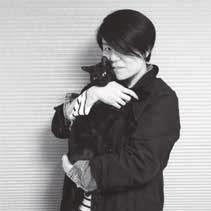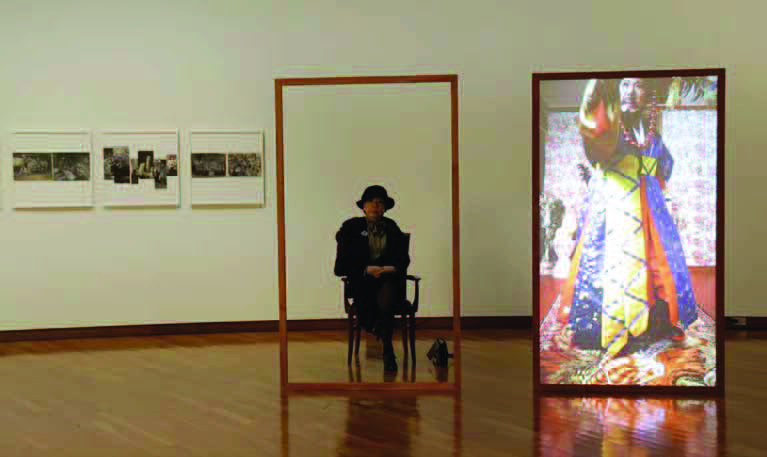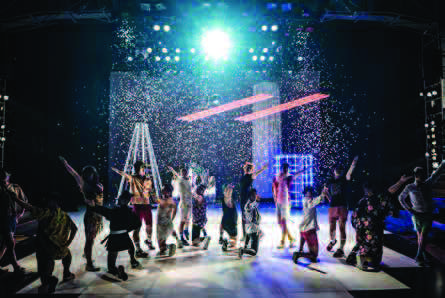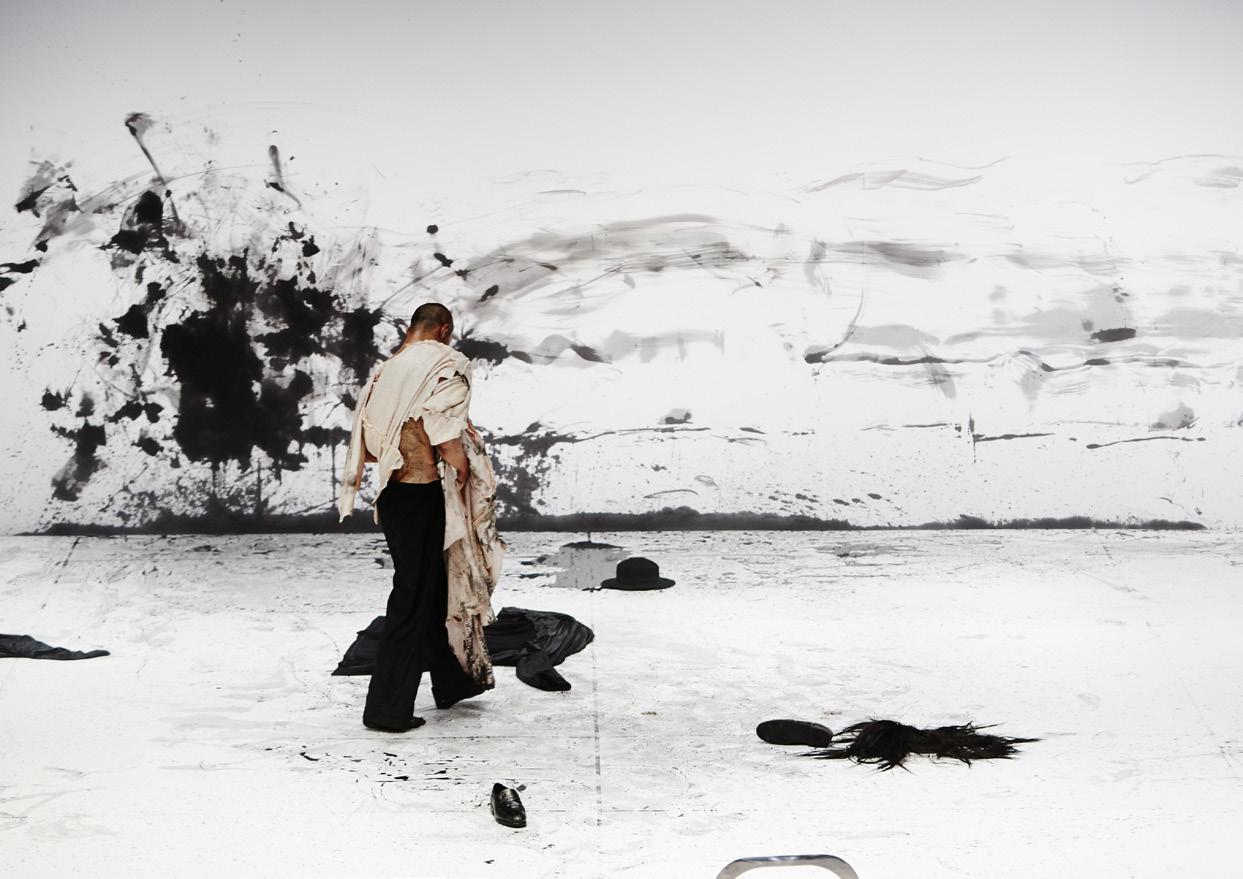Performance Info
siren eun young JUNG (Artist, Performance director)
: Gender, a performance in itself
You are labeled the ‘Feminist’-‘Artist’. How did you and the two words get related?
When I was about twelve, I really wanted to take art classes. I was even on a hunger strike until my parents allowed me. It was already natural for me then to think that I would become a fine artist.
I was raised in a conservative family with stereotypical ideas about gender-role. Rebelling against the family values, I became more skeptical about traditional gender roles. And around 1994, my sophomore year at art college, feminist movements started to gather pace in universities. No doubt it had a huge influence on me, being at the periphery of that movement. I had been longing for it.
You had long studied Western painting before getting current careers in video and performance, which are quite different from your earlier dedication. Are there any special reasons for the change?
I had been very much involved in a lot of material, realistic, and space-taking work like paintings and installations. When I was studying in England in 2003 and 2003, I had a lot of difficulty buying art supplies and keeping them. Furthermore, I felt under the weather a lot and was down with the flu half the time I was there. Given this, I turned my attention to an alternative form that allowed me to work in a smaller place like a small studio or dorm room. I started out with drawing, photography and video work.
The meeting with Yeoseong Gukgeuk community in 2008 led me begin a long research project on the performance genre called Yeoseong Gukgeuk and its actors. I was simply fascinated by them. I was filled with the urge to do this project. About two years into the project, however, I felt I was failing to ‘be with’ the actors in my video documentary work. This raised the question of: shouldn’t the actors get on stage? And it led me attempt to bring them on stage instead of in front of my camera. So I made (Off) Stage and Master Class in 2012, short performances running for 30 minutes each, and it was (off) stage/ Master Class in 2013 that was created by combining these two. This work provided me with the opportunity to seriously consider the ideas of stage and performance.
Could you elaborate on why you were fascinated by Yeoseong Gukgeuk?
As an artist who identified herself as feminist and a queer, I was primarily attracted to the de-normalization of gender roles in Yeoseong Gukgeuk. I couldn’t ignore the fact that this genre, which had once existed in the past but now left its vestige behind, can serve as a historically ever-lasting living fossil that is significant to us in terms of the ‘subversive possibility of female communities,’ ‘politics of de-normalization,’ and ‘performative gender.’
What do you think is the difference between your pervious artworks, performances and current works in theatres? An exclusive possibility of performance or its difficulties and limitations, for example.
The biggest difference and charm of performance arts from visual arts is in its emphasis on ‘liveness’ and ‘performativity.’ Specifically, I get seriously nervous about having to depend on this unpredictable atmosphere which is only possible at that certain moment, but that makes me realize even more that it actually enables me to do a living art. On the other hand, probably because of my long experience as a visual artist, sometimes I find it hard to deal with the anxiety and stress from not being able to take over or control everything as director.
What if you still had to choose one of your performances that exemplifies your artistic orientation?
I would choose I am not going to sing (2015). Based on the oral statement of a now-old supporting actor in Yeoseong Gukgeuk who took on male roles, I wrote a script that touched upon the historical and political and I arranged so that the raw materials, performance and video can be brought together into a layer of the piece.
Anomalous Fantasy, the Seoul version in 2016, fully reflected what I wanted to deliver based on the localities of my community. It was not a brilliant work, but I’m personally very fond of it. The Taipei version (2017, for Taipei Biennale) was performed with a local gay chorus. Instead of bringing an already complete performance, I had to constantly ‘re’-interpret and ‘re’-produce by reflecting the local circumstances and socio-political context, which was something fascinating about the localizing process and at the same time something that involved huge responsibility.
Soon it will be 10 years since you launched the Yeoseong Gukgeuk project in 2008. You’ve kept doing your research and film documentation, and continued with archive exhibition, performances and publication based on them.
When I first started my research on Yeoseong Gukgeuk in 2008, I had no plans whatsoever about its process or from where I should start, although my previous work veered my attention and nurtured experience in the methodology and political aspect of research-based art. Kind of getting on with it blindly, little by little I could think about the ways to make it into a work and gradually came up with the steps I should take.
Right now I’m carefully looking back on the things I have and have not accomplished for the last decade. I would like to complete the Yeoseong Gukgeuk project successfully, but also hope this wouldn’t be a denouement of this work.
What does it mean for you to the borders between genres, and further, to do art?
‘Genre boundaries’ in contemporary art scene are not something to be strictly preserved. Moving across genres brings out the difficulty in learning the formal characteristics of each art from, but the fact that I’m not fully aware of them often enables me to come upon a fresh approach. But still I try to grasp the internal logic and dynamics of each from in a more sophisticated way. I believe a good work is possible only when you sufficiently consider the form, even when you want to subvert it.
I think I’d like to talk about the complexity of the world through my work. Any notion in this world is probably a hodgepodge of logic, emotion, theory, practice, efficiency, history, politics etc. However, we often tend to simplify some of the notions intentionally in order to understand them. I always find such an attempt boring, and even disturbing to some extent. Maybe disclosing and problematizing the seams of certain notions is of my work, and art’s responsibility.
* Photo "Anomalous Fantasy" copyright : Namsan Arts Center
Production Details
- Director
siren eun young JUNG
Reference
- E-mailsirenssong@gmail.com












 PREV
PREV
.jpeg)
.jpg)
_(c)포스(FORCE).jpg)
_(c)장석현_코끼리들이 웃는다(SUKHYUN JANG_ELEPHANTS LAUGH).jpg)
.jpg)
.jpg)
_(c)한받(Hahn Vad).jpg)
_(c)비주얼씨어터 꽃(CCOT)(1).jpg)
_(c)봉앤줄 (BONGnJOULE)(1).jpg)
_(c)대한민국연극제 2019 (Korea Theater Festival 2019)(0).jpg)
_(c)몸꼴(Momggol)(1).jpg)
.png)
2018MODAFE_Taemin Cho (2).jpg)











